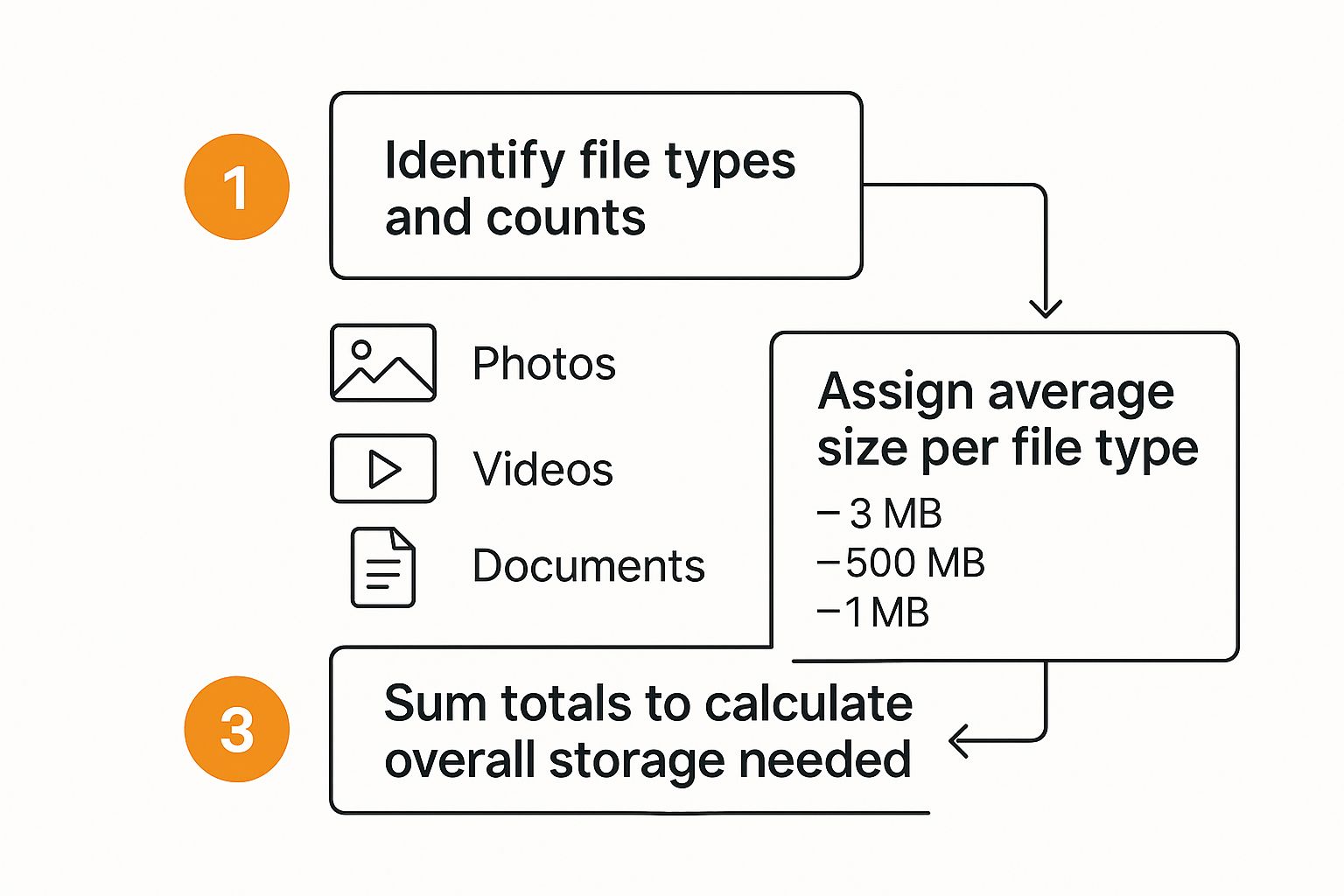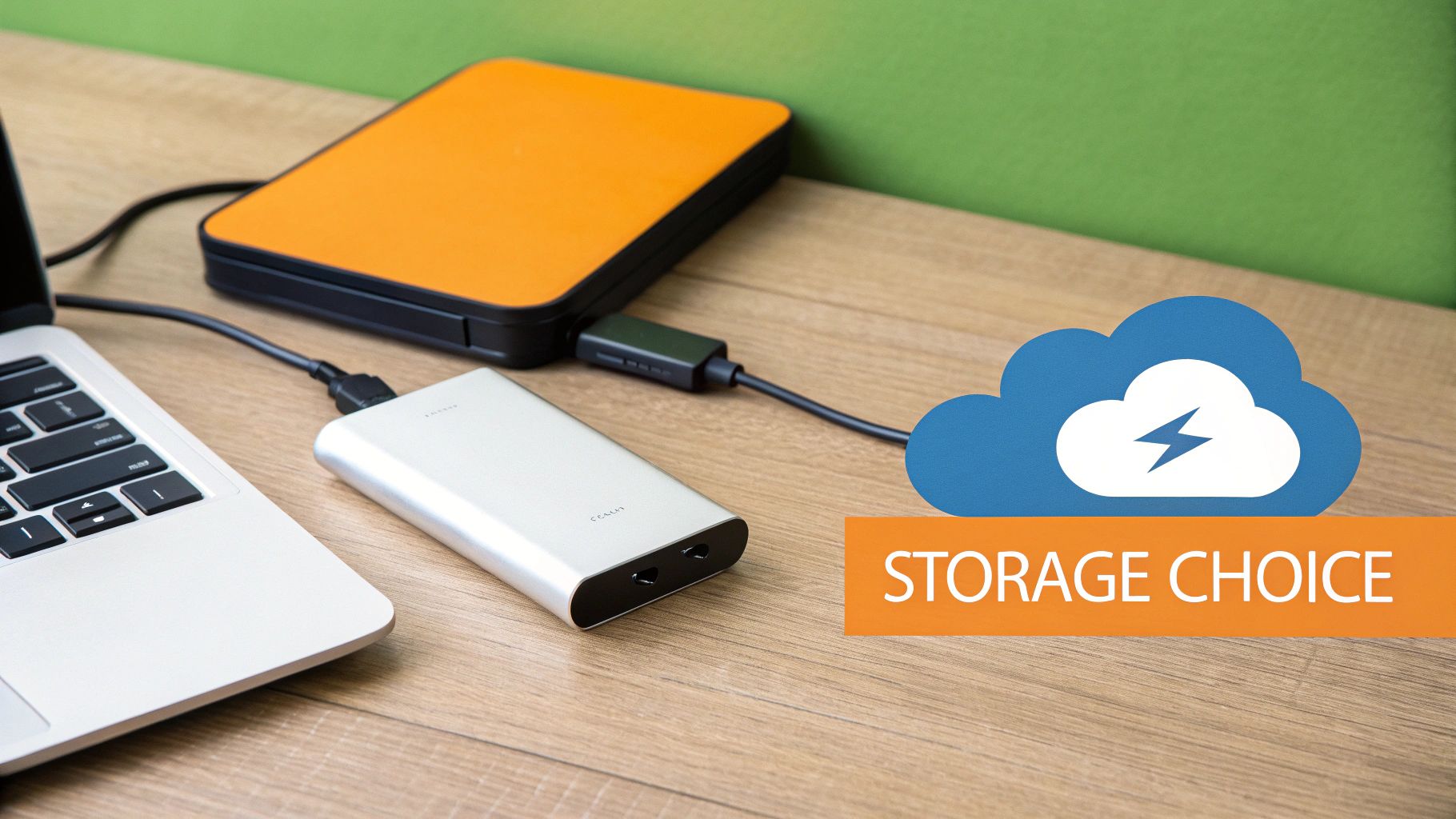Figuring out how much storage you need can feel like a bit of a guessing game, but it usually comes down to a few standard sizes. As a rule of thumb, a 50 sq ft unit is one of our most popular choices. It’s about the size of a large garden shed and typically offers plenty of room for everything from a one-bedroom flat. This gives you a solid starting point for most common storage situations.
Your Quick Guide to Common Storage Unit Sizes
When you’re staring at a room full of belongings, trying to translate that into square feet can feel like abstract maths. It's much easier to connect storage unit dimensions to familiar spaces you already know. A small unit might be perfect for a quick declutter, while a larger one is essential for a full house move.
To help you get a better feel for it, we’ve put together a simple cheat sheet. This table gives you a quick visual reference, matching standard UK unit sizes with real-world equivalents and the sort of things they can hold. Think of it as a way to get an immediate, practical idea of what you’ll need before you even break out the tape measure.
UK Storage Unit Size and Capacity Guide
| Unit Size (sq ft) | Equivalent To | What It Typically Holds |
|---|---|---|
| 25 sq ft | Large walk-in wardrobe | A small amount of furniture, garden tools, and around 20-30 boxes. Ideal for student storage. |
| 50 sq ft | Large garden shed | Contents of a one-bedroom flat, including a sofa, double bed, and major appliances. |
| 75 sq ft | Luton-style van | Furnishings from a standard two-bedroom house, minus large appliances like washing machines. |
| 100 sq ft | Single garage | Contents of a two-bedroom house, including appliances, sofas, and dining sets. |
| 150 sq ft | Garage and a half | All items from a three-bedroom house, plus shed and loft contents. A great option for larger moves. |
This guide should give you a pretty clear picture, but remember that every move is different.
Beyond the Basic Dimensions
While the table above is a great starting point, a few other factors can influence your final decision. The way you plan to pack and access your unit is just as important as its size.
Here are a couple of things to keep in mind:
- Your Stacking Strategy: If you can safely stack boxes and items vertically, you can often make a smaller space work harder. Just be sure to put the heavier, sturdier items at the bottom to create a stable base.
- How Often You'll Need Access: Do you need to get to your things regularly? If so, you'll want to leave a clear walkway down the centre of the unit. This little bit of organisation might mean you need to rent the next size up to accommodate the path.
My advice? It's almost always better to choose a unit that's slightly too big than one that's a fraction too small. The stress of realising your belongings won't fit on moving day is something you definitely want to avoid.
Thinking about these details is key to making the right choice. For a deeper dive into what to expect from a facility, our self storage facility basics guide has even more valuable insights. Getting it right now will save you a lot of headaches—and extra costs—down the line.
Creating a Realistic Storage Inventory
Before you can even begin to answer the question "how much storage do I need?", you have to know exactly what you’re putting away. Think of a detailed inventory as your roadmap—it’s the single most important tool for preventing you from renting a unit that’s either bursting at the seams or needlessly large.
The good news? This doesn't have to be a monumental chore. Forget spending hours with a clipboard and pen. Modern methods make creating a solid inventory surprisingly quick and painless.
Streamline Your Inventory Process
The simplest way to get started is with the phone in your pocket. Just walk through your home, room by room, and take clear photos or a slow-panning video of everything you plan to store. This gives you an instant visual record you can refer back to anytime.
For a more organised approach, a basic spreadsheet is your best friend. Create simple columns for the item, its original room, and rough dimensions. This method is brilliant not only for calculating the space you need but also for making it much easier to find things later on. To get ahead of the game, check out our guide on how to effectively organise your self storage container.
Account for Awkward and Bulky Items
Let's be honest, some belongings are notorious space-hogs. That ridiculously comfortable L-shaped sofa or the bulky treadmill you bought during lockdown often demand far more floor space than you’d imagine. These are the items that can quickly push you into needing a bigger unit.
Always measure these large, awkwardly shaped pieces first, as they will literally form the foundation of your storage plan. It's also worth considering what can be dismantled. A dining table with its legs removed, for instance, becomes a flat, easy-to-store panel rather than a giant, cumbersome object taking up prime real estate.
Keep an eye out for these common culprits:
- Exercise Equipment: Treadmills, exercise bikes, and weight benches are almost always non-stackable.
- Large Furniture: Sectional sofas, wide-screen TVs, and wardrobes that can’t be taken apart.
- Outdoor Gear: Lawnmowers, bicycles, and large garden furniture sets.
Don't make the classic mistake of only thinking about floor space. Vertical height is your secret weapon in a storage unit. Accurately knowing what you have allows you to plan how to stack items safely and efficiently, maximising every cubic foot you're paying for.
Remember the Hidden Spaces
Finally, it’s absolutely crucial to inventory the places we all tend to forget about until the last minute. The contents of your loft, garage, and garden shed can easily add up to an extra 25-50 sq ft of required space.
These spots are usually crammed with irregularly shaped items like garden tools, half-used paint tins, and boxes of seasonal decorations. Be thorough and get everything down on your list. An accurate inventory is your guarantee against showing up on moving day only to realise you’ve run out of room. A bit of careful planning now ensures you select the perfect unit size from the start, saving you time, money, and a whole lot of unnecessary stress.
How to Calculate Your Required Storage Space
Once you’ve got a full inventory list, you’re ready to turn that list into a real number. Answering "how much storage do I need?" is no longer guesswork; it becomes a straightforward calculation. You don't need to be a maths whizz—just a basic formula and a clear idea of your items will do the trick.
The easiest place to start is with your biggest items. Grab a tape measure and get the length, width, and height of pieces like your sofa, wardrobe, and fridge. Multiply them together (L x W x H) to get the cubic metres for each one. This gives you a solid foundation for your total space estimate.
For all the smaller bits and pieces packed into boxes, you can estimate. A standard large moving box is roughly 0.1 cubic metres. Got 20 of them? That’s 2 cubic metres right there. This methodical approach helps you avoid the common mistake of only thinking about floor space and forgetting how much you can stack upwards.
A Practical Two-Bedroom Flat Example
Let’s put this into practice with a real-world scenario. Imagine you’re moving out of a typical two-bedroom flat. Your inventory includes a large sofa, a double bed, a dining table with four chairs, a washing machine, and about 30 boxes of various sizes.
Here’s what a quick calculation might look like:
- Sofa: 2m x 1m x 0.9m = 1.8 m³
- Double Bed (Dismantled): The frame, headboard, and mattress can be stored vertically, taking up far less floor space. Let's estimate this at 1.5 m³.
- Dining Table (Dismantled): Taking the legs off turns it into a much more manageable flat panel. Let's say this now takes up only 0.5 m³.
- Washing Machine: 0.6m x 0.6m x 0.85m = approx. 0.3 m³
- 30 Assorted Boxes: Averaging these out, we can estimate around 3.0 m³.
Add it all up, and you get a total of 7.1 cubic metres. A 50 sq ft unit (which is roughly 4.6 sq metres) with a standard height of 8 ft (2.4m) has a total volume of around 11 cubic metres. This would comfortably fit all your belongings and still leave you room for a walkway. It's the perfect fit for this situation.
The Smart Way to Reduce Your Needs
As you can see from the example, dismantling furniture is your secret weapon for saving space. A bed frame or dining table can seem enormous when assembled but becomes surprisingly compact once taken apart. Always check what can be flattened or broken down—it could be the difference between needing a 50 sq ft unit and a much larger 75 sq ft one.
The infographic below breaks down a simple three-step process for estimating your total required storage.
This visual guide shows that by simply identifying what you have and giving it an average size, you can quickly get to an accurate total.
To help you with your own calculations, here are some average volume estimates for common household items.
Estimating Volume for Common Household Items
| Item | Average Dimensions (L x W x H) | Estimated Volume (m³) |
|---|---|---|
| Three-Seater Sofa | 2.0m x 0.9m x 0.9m | 1.62 |
| Armchair | 0.9m x 0.9m x 0.9m | 0.73 |
| Double Bed & Mattress | 1.9m x 1.4m x 0.6m | 1.60 |
| Wardrobe (Assembled) | 1.2m x 0.6m x 1.8m | 1.30 |
| Dining Table (4-person) | 1.2m x 0.8m x 0.75m | 0.72 |
| Fridge Freezer | 0.6m x 0.6m x 1.8m | 0.65 |
| Washing Machine | 0.6m x 0.6m x 0.85m | 0.31 |
| Large Moving Box | 0.6m x 0.4m x 0.4m | 0.10 |
These figures are a great starting point, but always remember to measure your own specific items for the most accurate estimate.
When to Use Online Storage Calculators
Online storage calculators can be a handy starting point, especially if you just need a quick ballpark figure. The catch is they often rely on generic averages that might not reflect your specific belongings, particularly if you have unusually shaped or oversized items.
A manual calculation based on your own inventory will always be more reliable. Use online tools for a preliminary idea, but trust your own measurements for the final decision. This ensures you’re not paying for space you don’t need.
It’s clear that more and more of us are finding ourselves in need of extra space. The UK self-storage sector expanded by 7.2% in the past year, reaching a massive 64.3 million square feet of space. This trend highlights a growing need for flexible solutions, whether for a few months during a renovation or for longer-term needs.
If you’re in a short-term situation like moving or renovating, finding the right fit is key. Our guide to temporary storage near you provides more advice on making a smart choice. Ultimately, an accurate calculation gives you confidence and puts you in control.
Matching Your Needs to the Perfect Storage Unit
Alright, you've done the maths and have a rough volume estimate. Now it's time to turn that abstract number into a real-world space. This is where we move from cubic metres on paper to picking a physical unit that’s just right for what you’re storing. It's not just about getting enough space, but the right kind of space.
To make things easier, let's put the standard UK unit sizes into perspective. Think of a 25 sq ft unit as roughly the size of a large garden shed. It’s ideal for the contents of a student flat or if you're just decluttering a spare room. On the other end of the scale, a 100 sq ft unit is much more like a single-car garage and can comfortably hold everything from a two-bedroom house.
Planning for Access and Usability
Here's something people often forget: how will you get to your stuff? If you're just archiving boxes you won't touch for years, you can pack everything in as tightly as possible. Job done.
But what if you need to grab things regularly? Maybe it's seasonal decorations, business stock, or your camping gear. If that’s the case, you absolutely need to leave yourself a walkway. A clear path down the middle makes all the difference. This little bit of planning might mean you need to bump up to a slightly larger unit than your calculation suggested, but it’s a trade-off that pays for itself in sheer convenience. Trust me, you don't want to be emptying half the unit just to find one box at the back.
The goal isn’t just to fit everything in; it's to make the space work for you. A well-organised, slightly larger unit is always more practical than a smaller one packed to the ceiling with no room to move.
Considering Specialised Storage Options
Beyond just the dimensions, think about what you're storing. Not all belongings are created equal, and some need a bit of extra TLC. This is where you might need to look at more specialised units, like climate-controlled storage.
Do you have any of these?
- Antique wooden furniture that could warp or crack with temperature swings.
- A collection of vinyl records or delicate electronics sensitive to moisture.
- Important documents or artwork that could be ruined by damp.
If anything on that list sounds familiar, a climate-controlled unit is a very smart move. These units keep the temperature and humidity levels stable, protecting your sensitive items from the UK's notoriously damp climate. It’s a crucial detail that ensures your valuables come out in the exact same condition they went in. In fact, getting this right is one of our key 10 tips for choosing a self storage facility.
The need to manage our belongings—both physical and digital—is always growing. It’s interesting to see how trends in digital storage reflect this. By 2025, over 62% of UK adults were using personal cloud services, driven by things like 4K video. This shows a broader need to manage more "stuff," whether it's tangible or virtual, and really highlights why picking the right storage solution matters so much.
More Than Just Size: What Really Matters When Choosing a Unit
Figuring out the right unit size is a great start, but it's only half the battle. Once you've got a handle on the answer to "how much storage do I need?", a few other critical factors come into play. Nailing these details ensures your final choice isn't just the right size, but also secure, convenient, and a perfect fit for your situation.
First up, location. A city-centre facility is brilliantly convenient, letting you pop in and out with ease. But that prime real estate usually comes with a higher price tag. On the flip side, a facility on the outskirts of town might have more competitive rates, but you’ll need to weigh those savings against longer travel times and fuel costs.
Nailing Down Security and Access
When you’re trusting a facility with your belongings, security should be a top priority. Don't just assume all locations offer the same level of protection. You want a comprehensive setup that gives you complete peace of mind.
Here’s what to look for:
- 24/7 CCTV Monitoring: Cameras should cover all main access points, corridors, and the site's perimeter.
- Secure Perimeter Fencing: This is the first line of defence against anyone who shouldn't be there.
- Controlled Access Gates: You want to know that only registered customers can get in, usually with a unique PIN code or key fob.
- On-Site Staff: Having staff around during business hours adds another layer of security and means there's someone to help if you need it.
Access is just as important. Your schedule should dictate when you can get to your things, not the other way around. If you’re a tradesperson needing to grab tools at the crack of dawn or a business owner managing stock outside the usual 9-to-5, 24/7 access is a must-have. For others, standard business hours might be perfectly fine.
Think carefully about how and when you'll need to get to your items. Paying for 24-hour access you'll never use is a waste, but being locked out when you desperately need something is far more frustrating.
Getting Your Head Around Insurance
Finally, let's talk about insurance. Most reputable storage facilities will require you to have cover for your stored goods, and many will offer their own policy. It's vital to understand exactly what you're covered for. Usually, the facility's insurance protects against big events like fire or theft, but you absolutely have to read the fine print.
This is more relevant than ever. As of 2025, an incredible 97.8% of the UK population are internet users, with 79% actively using social media. This shows how we're all accumulating vast amounts of both physical and digital "stuff," making proper protection for our assets essential. You can learn more about our digital habits from DataReportal's 2025 analysis of the UK.
Before you sign anything, check if your home insurance policy extends to items in storage. If not, you'll need to arrange a separate, specialised policy. This final check ensures your valuables are fully protected, no matter what.
Still Have Questions About Choosing Your Storage Space?
Even with the best planning, a few questions always seem to surface right before you commit to a unit. It’s completely normal. Getting these last-minute details sorted can be the difference between a smooth move and a really stressful one, so let's clear up a couple of the most common queries.
Probably the biggest dilemma people face is whether to play it safe and rent a slightly larger unit, just in case. It's a tempting idea, but when is it a smart move, and when is it just wasted money?
Should I Rent a Bigger Unit Than I Actually Need?
Honestly, sometimes going one size up is a brilliant move. If you're storing business stock, for example, having that extra wiggle room for new inventory is a must. It's also a great idea if you know you'll be popping in and out of your unit a lot and want to keep a clear, wide walkway for easy access.
But let's be realistic. If you're storing things long-term and don't plan on touching them for months or even years, paying for empty space every month just doesn't make sense. In that case, a well-packed, correctly-sized unit is far more cost-effective. The key is to think about how you'll actually use the space, not just what you're putting in it.
The most common mistake people make isn't just miscalculating space; it's forgetting all the small stuff. We tend to focus on big furniture but completely overlook the dozens of boxes, bags, and random bits that take up a surprising amount of room. Always, always account for everything.
How Can I Get the Most Out of My Storage Space?
Once you’ve picked your unit, packing it efficiently is the next game to win. A smart packing strategy can feel like you’ve magically unlocked extra square footage, keeping everything safe, organised, and easy to get to later. It’s all about working smarter.
Here are a few pro tips I’ve picked up over the years:
- Create a Central Aisle: This is non-negotiable if you need to get to your stuff. Leave a path down the middle, from the door to the back wall. You’ll thank yourself later.
- Use Uniform Boxes: Sticking to sturdy, same-sized boxes makes a world of difference. They’re much easier to stack securely than a random collection of bags and odd containers, letting you build stable, wall-like structures.
- Heavy at the Bottom, Light on Top: This one’s a classic for a reason. Place your heaviest things, like appliances and solid furniture, on the floor first. Lighter boxes and fragile items always go on top to prevent anything from getting crushed.
- Take Everything Apart: If it can be disassembled, do it. Take the legs off tables, break down bed frames, and dismantle any furniture you can. You can then store these larger pieces vertically against the walls to save a huge amount of floor space.
- Label Like Your Sanity Depends on It: Because it might! Make sure every box is clearly labelled on multiple sides with its contents and which room it belongs to. This simple step will save you from tearing your hair out when you’re trying to find that one specific thing.
Following these simple rules will help you maximise every inch of your unit, keeping your belongings protected and accessible whenever you need them.
Ready to find the perfect storage solution without all the guesswork? At Standby Self Storage, we keep things simple. With our clear pricing and flexible terms, you can book the ideal unit online in minutes. Find your perfect space today with Standby Self Storage.




